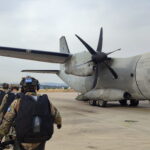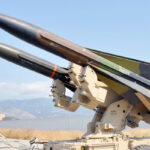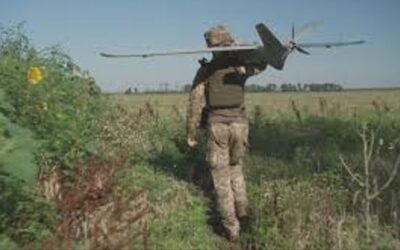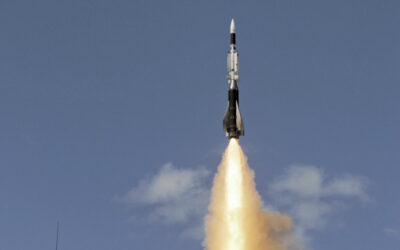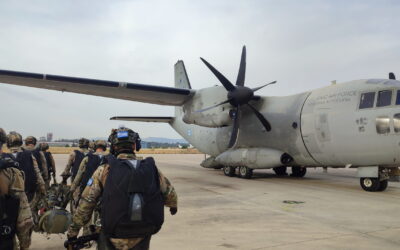Kiev is increasing spending by 15.5 billion hryvnias (367 million euros) to bolster Ukraine’s armed forces with drones, according to…
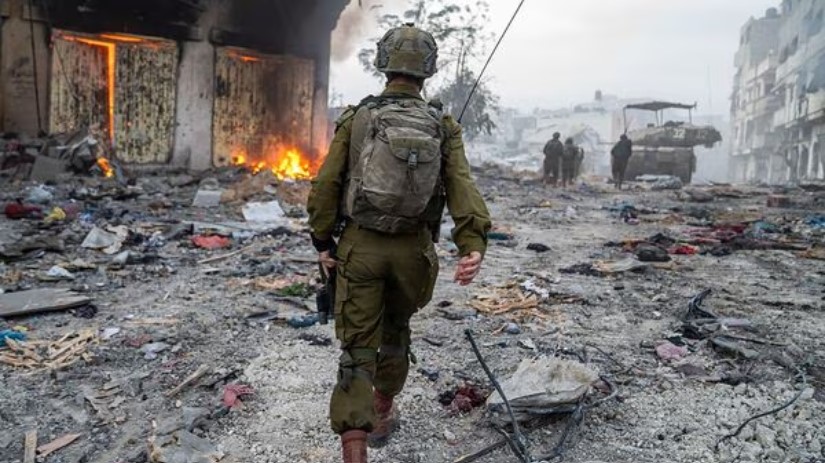
The world may be navigating the challenges of a new year, yet the ongoing conflicts and tensions across various regions are still a tough reminder of reality and the constant need for peace and stability.
In 2023 we witnessed a number of conflicts, from civil wars to territorial disputes, each leaving a profound impact on global geopolitics and human life. Looking into these multifaceted conflicts sheds light on critical hotspots and recent developments that demand immediate attention and concerted international efforts.
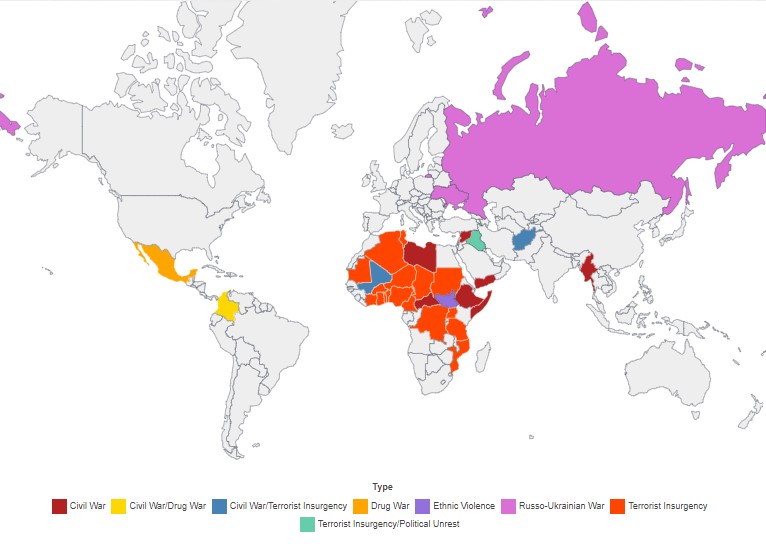
Middle East and North Africa
Morocco – Algeria
The earthquake that struck Morocco in September, 2023 created an opportunity to ease tensions between the kingdom and its neighbor, Algiers, which severed diplomatic ties in 2021.
The 6.8-magnitude quake killed more than 2,000 people and left thousands more homeless in the community of Amizmiz. With relief efforts underway, Algerian authorities opened their airspace to planes headed to Morocco and offered three military aircraft loaded with humanitarian aid and support personnel to help Moroccans. The Moroccan government turned down the aid, however, saying it wasn’t needed.
Also read: 2020 | A year full of wars – The deadliest conflicts around the world
The moment represented a fleeting improvement in relations between Algeria and Morocco, which have had a closed border since 1994. The two neighbors have had a tense relationship for decades fueled partly by the status of Western Sahara. Morocco claims the territory and Algeria supports its independence.
On a diplomatic level, Morocco has built ties with Western countries and supports Ukraine, while Algeria has cultivated connections with Russia and China.
Lebanon
Daily skirmishes between Hezbollah and the Israel Defence Forces (IDF) along the Lebanon-Israel border continued in 2023 especially after October 7, though hostilities were halted during the last week of the month following the announcement of a temporary ceasefire between Hamas and Israel.
Syria
Forces loyal to the government of President Bashar al-Assad control most of Syria, but rebel groups continued to operate in the north, including in Idlib province. The Syrian government and its ally, Russia, kept striking rebel groups in the northwestern province.
The US-backed, Kurdish-led Syrian Democratic Forces (SDF) continued to control much of north-eastern Syria. Turkey considers the groups constituting the SDF to be affiliates of the outlawed Kurdistan Workers’ Party (PKK). The Turkish military continued striking Kurdish forces in the northeast.
Moreover, clashes in September between the SDF and Arab tribes in Deir Ezzor province left 90 dead. ISIS, despite being weakened, also continued to carry out attacks in Syria. As of early December, a total of 941 civilians had been killed in Syria this year, according to the Syrian Observatory for Human Rights. The Syrian government, the SDF, Turkish forces in northern Syria, and landmines were responsible for these casualties, among other causes.
Iraq
Turkey continued striking PKK forces in northern Iraq in 2023. In October, it struck targets across the autonomous Kurdistan region in response to a suicide bombing in Ankara.
According to the International Crisis Group, 151 PKK fighters, 41 state security forces, and four civilians were killed in the Turkey-PKK conflict in 2023. The Brussels-based organization did not specify the nationalities of those killed.
As in Syria, ISIS also remains active in Iraq. Overall, however, ISIS capabilities remained degraded and the group operated in survival mode in Iraq and Syria, according to a US Defence Department report on the fight against ISIS for the third quarter of 2023.
Yemen
The Yemeni civil war between Iran-backed Houthi forces and the Saudi-backed government has slowed since a truce was reached last year.
The Houthis and Saudi Arabia have yet to reach a lasting peace agreement and Houthi attacks on Israel in connection to the Gaza war are threatening the Yemeni peace process.
Libya
The Tripoli-based government and the eastern-based forces of Gen. Khalifa Hifter agreed to a ceasefire in 2020 to end the civil war. To date, Libya is still in the midst of attempting to unify following a six-year civil war.
Israel – Hamas
The war (Swords of Iron operation) between IDF and Palestinian organizations Hamas and Palestinian Islamic Jihad (PIJ) broke out on October 7, 2023, when Hamas launched an unprovoked land, sea, and air assault on Israel from the Gaza Strip.
The October 7 attack resulted in more than 1,200 deaths, primarily Israeli citizens, making it the deadliest day for Israel since its independence. More than 240 people were also taken hostage during the attack, with more than 100 persons currently being held hostage or are still missing.
The next day of the attack (October 8), Israel declared itself in a state of war for the first time since the Yom Kippur War in 1973. The war began with the Israel Defence Forces (IDF) conducting air strikes on the Gaza Strip, followed by the incursion of ground troops and armored vehicles weeks later.
Also read: Israel | A three-phase Israeli operation in Gaza
Ukraine
The Battle of the Black Sea has escalated significantly during 2023. International attention has focused on the Ukrainian counter-offensive which has not led to the desired results across the front line, except for certain occasions. However, Russia’s Black Sea Fleet has been pushed out of the northwestern Black Sea, with most Russian warships retreating in recent months from their traditional home port of Sevastopol in Russian-occupied Crimea. The reason is apparently the massive back-to-back hits of Russian vessels (including the Rostov-on-Don Kilo-class submarine) by the Ukrainians using Scalp-Storm Shadow missiles and USVs.
Moreover, a combination of Ukrainian Special Operation Forces raids and surgical airstrikes against Russian air defences (S400 in Crimea), logistical hubs of the Russian Army, and shipping routes appears to be effective. Ukraine has used innovative naval USVs and Western-supplied missiles to damage or destroy a growing number of Russian vessels and hit key targets, including the headquarters of the Russian Black Sea Fleet.
Satellite footage and international media reports in early October 2023 confirmed that most of the Russian Black Sea Fleet had been withdrawn from Crimea to the relative safety of Russian ports.
While it is far too early for Ukraine to declare victory in the Battle of the Black Sea, the successes achieved in the past year are arguably no less significant in terms of their impact on the war than the liberation of Kharkiv and Kherson regions in the final months of 2022. In addition to forcing Putin’s fleet to retreat, Ukraine’s attacks on Russian-occupied Crimea have also significantly weakened the logistical networks that are essential for the Russian Army in southern Ukraine.
Crucially, Ukraine has also been able to ease the blockade of the country’s Black Sea ports. Russia began blockading Ukraine’s Black Sea coast on the eve of the full-scale invasion. This blockade was partially lifted by a UN-brokered Grain Deal in July 2022, but Russia was soon attempting to leverage its continued participation in the agreement to blackmail the international community. It came as no surprise when Putin officially confirmed Russia’s withdrawal in summer 2023, questioning the future of Ukraine’s maritime trade.
Ukraine responded to this latest setback by unilaterally announcing the establishment of a new humanitarian maritime corridor for merchant vessels sailing to and from Ukraine’s Black Sea ports. This would have been unthinkable in the first months of the Russian invasion, but Ukrainian progress in the Black Sea region during the summer of 2023 meant a new corridor was an actual possibility.
By early December 2023, more than 200 ships had passed through Ukraine’s Black Sea humanitarian corridor, carrying over seven million tons of grains, metals, and other cargo.
Also read: Distributed Lethality | Ukraine’s A2/AD example may be applied with made-in-Cyprus USVs
Armenia – Azerbaijan
The borders between Armenia and Azerbaijan witnessed relative “calm” after Azerbaijan’s offensive in September 2023 and Artsakh’s total occupation.
Also read: Azerbaijan | Military parade in the capital of Nagorno-Karabakh – Photos
Attempts to start peace negotiations between Armenia and Azerbaijan proved mostly futile. In the wake of Western criticism for the forceful takeover of Artsakh, Azerbaijan shunned the European Union-proposed fora in early and late October, opting for a Foreign Ministers’ meeting including Russia and Iran, while Armenian Prime Minister, Nikol Pashinyan, skipped a Russian-sponsored event.
Armenia’s ratification of the Rome Statute of the International Criminal Court further strained its relations with Russia, as the Court is prosecuting Russian President, Vladimir Putin, for the abduction of children from Ukraine. Furthermore, while Armenia expressed its will to sign a peace treaty to mitigate military threats to its territory between mainland Azerbaijan and Nakhchivan, Azerbaijan, and Iran started to build a road and rail connection to the exclave bypassing Armenia.
Azerbaijan has also questioned Armenia’s announced purchase of air defence equipment from France and demanded the return of Azerbaijani enclaves within Armenia. It also organized drills with Turkish forces in Nakhchivan and areas formerly under Artsakh control.
Also read: Armenia – France | Historic agreement and first move of independence from Russia
Balkans
Kosovo fought for its independence from Serbia in the late 1990s, which was declared in 2008. Yet Belgrade has never recognized Pristina and tensions between the neighbours flared in 2023 over demands for autonomy by ethnic Serbs living in northern Kosovo.
In February, Brussels announced that Kosovo and Serbia had agreed to a plan on a “path to normalization”. In fact, they only pretended to agree. Since then, neither has taken any action to implement any of its main provisions. In September, a Serb paramilitary group clashed with Kosovo police.
Belgrade and Pristina have many disagreements, but two of them stand out. The first is about Kosovo’s relations with other states and its membership in international organizations. Serbia sees Kosovo as a breakaway province rather than an independent state and pressures others not to recognize it or accept it as a member.
The second disagreement is about Kosovo’s Serb minority, about 100,000 people, with half living near the Serbian border in northern Kosovo. While Serbia formally claims all of Kosovo as its own soil, it only really wants the northern four municipalities where Serbs are a large majority.
Belgrade and Pristina both act as sovereigns in this territory in an unstable and increasingly dangerous equilibrium. Kosovo runs the police, while Serbia runs the schools. Kosovo operates the border posts, while Serbia runs the hospitals and clinics. Both operate municipal governments. Serbia spends much more than Kosovo on the area and the population is loyal to it.
The recently proposed normalization plan (a slight variation on the EU’s February 2023 plan) addresses both major disagreements. It asks Serbia to recognize Kosovo: to stop opposing other governments’ decisions to recognize it or accept it as a member of international organizations, including the UN. For its part, Kosovo must implement earlier commitments to give its Serb minority a degree of self-government and access to Serbian services.
Recent escalations render the return to conflict more likely, thus acceptance of this plan (or other viable plan) by both parties is more urgent.
Central Asia
In 2023, the security situation in Central Asia shows stability and improvement compared to last year.
Firstly, relations between regional countries are generally improving. In the past few years, conflicts between some Central Asian countries have occurred over issues such as border demarcation and water resources competition, resulting in casualties and property losses. In order to prevent such a situation from happening again, Central Asian countries initiated a “stability first” conflict management model. This year, Kyrgyzstan and Tajikistan demarcated 90 percent of their borders and effectively prevented the recurrence of border conflicts.
However, there are still disputes over border demarcation between Kyrgyzstan and Uzbekistan and between Tajikistan and Uzbekistan. Disputes between countries over the use and development of water resources have not been effectively resolved. Future conflicts in Central Asia due to border demarcation and allocation of water resources, for instance, are still likely.
Furthermore, countries in the region have maintained reasonable and moderate military build-up. Affected by the conflict between Russia and Ukraine, Central Asian countries have reassessed the international security situation and focused on improving their military defence capabilities and on strengthening regional security cooperation.
Kazakhstan and Kyrgyzstan have successively issued new versions of military doctrines, stating that responding to new security threats will be a strategic goal of military security.
Since the beginning of this year, the balanced diplomatic policy of Central Asian countries has become more obvious and countries in the region have actively promoted the convening of C5+1-type summits, which is a representatives’ meeting for dialogue and cooperation between the five Central Asian countries and major powers and international organizations.
Relevant reports show that the five Central Asian countries have successively held C5+1 summits with China, the EU, the Gulf Cooperation Council, the US, and Germany this year. In 2024, the five Central Asian countries will also hold a C5+1 summit with the EU and Japan, and more C5+1 summit mechanisms are still being planned and implemented.
Also read: Organization of Turkic States | Pseudo-state designated as “observer” – Foreign Ministry’s response
South – South-Eastern Asia
Territorial disputes in Asia remain a challenge to the peace, stability, and prosperity of the region.
Of all interstate disputes, those over territory tend to be more likely to lead to armed conflict. A combination of political and economic interests, normative reasons, and competition over scarce natural resources have been identified as drivers of conflict over disputed territories.
The list of disputes presented in this article should be considered indicative rather than exhaustive, selected to provide insight into 2023 disputes and conflicts in the area.
- Thailand / Cambodia Dispute: While the dispute between Thailand and Cambodia dates back to the colonial period of the region, the most important factor that led to the escalation of the dispute in 2008 and the subsequent clashes till today has been domestic politics in Thailand.
- India / Pakistan Dispute(s) – Jammu and Kashmir: The origins of this dispute can be traced to the legacy of the British colonial rule in India and the nature of the British departure from the Indian subcontinent in 1947-1948. Tensions in the Indo-Pak border can also be exacerbated by competition over resources, for example, tensions between India and Pakistan have risen lately over the Baglihar dam construction over River Chenab in Indian-administered Kashmir.
- India / China Dispute(s): Latest India / Chinese relations are largely cordial and key factors in regional stability. After the 1987 incident, relations between the two Asian giants transformed into a cold peace and both sides officially maintained their territorial claims, whilst accepting the status quo.
- Nepal / India Dispute: In spite of predominantly cordial relations, there are times when border issues have taken a critical turn.
- Bangladesh / India Dispute(s): The India–Bangladesh border is the fifth largest land border in the world measuring some 4096.7 km. The India–Bangladesh border is viewed as a ‘security concern’ by New Delhi which has sought to securitise the border with Bangladesh, with concerns over the insecure nature of the border, making it accessible to militant groups and smugglers.
- Bangladesh / Myanmar Dispute(s): The influence of geopolitics is evident in border disputes between Myanmar and Bangladesh. Myanmar occupies a strategic location bordering China and India and is connected with the Indian Ocean through the Bay of Bengal. Crime has also emerged as a significant issue in the region with Myanmar emerging as a significant hub for the production and distribution of methamphetamine and its derivatives in 2023.
- South China Sea Maritime Disputes: The territorial and maritime disputes in the South China Sea are considered some of the most complex conflicts in the region, if not worldwide. The disputed areas are abundant in natural resources such as gas and oil and also carry strategic importance, as roughly half of the world’s commercial shipping passes through them. These disputes played an important role not only in the relations among those claiming ownership, but also in the foreign policies of countries such as Japan and the United States. The disputes involve overlapping maritime, territorial, and fishing rights and claims by China, Taiwan, Brunei, the Philippines, Vietnam, Indonesia, and Malaysia.
Also read: Jinping on Taiwan | Pursuing peaceful reunification without renouncing the use of force
Africa
The continent’s resilience has been tested over the years in many ways, making it stand stronger with more zest for change. Africa still accounts for the highest number of internal conflicts in the world. According to UNHCR and the International Organisation for Migration (IOM), at least 40 million people on the continent have been displaced this year alone due to various issues, primarily conflicts.
Of these 40-odd million people, 77% are believed to be internally displaced. Most recent statistics released by IOM and UNHCR show at least 15 African countries embroiled in internal conflicts that have caused many people to flee their homes.
Sudan: Although there have been clashes and attacks in parts of Africa since the beginning of the year, the greatest took place on April 15, 2023. Fierce fighting between the Sudanese Armed Forces and the paramilitary Rapid Support Forces resulted in the immediate displacement of over 3.3 million civilians, including internally displaced people and refugees. The conflict went on to become one of Africa’s deadliest conflicts, with the death toll constantly increasing.
As of December, 12,000-odd people had been killed in the fighting, with another eight million left homeless. Multiple mediating efforts between the warring sides have failed, and mediating talks for a lasting ceasefire are ongoing.
Also read: Sudan | The Greek C-130 took off from Khartoum with 39 people – 20 Greek citizens
DRC: Mineral-rich DRC held elections on December 20 amid fears of continuing violence, especially in the East. So far, at least 7.9 million people have been displaced either internally or as refugees in neighboring nations. Over 100 militant groups have set up camps in the vast country, fighting for control of the country’s mines and natural resources. Previous governments have had little or no success in disarming these groups.
Ethiopia: Although still being considered among the African countries affected the most by conflict, Ethiopia has recently witnessed a decline in the number of people displaced by such depredations.
By the end of 2022, at least 1.8 million people had been displaced due to internal struggles in the Tigray area. 2023 reports have demonstrated renewed fighting in Tigray.
West Africa: As African countries renew their democratic ‘vows’, change of government is one of the most sensitive issues that have tested the essence of democracy on the continent.
Over the last three years, at least seven coups d’état have taken place in West Africa, with the latest being the August coup in Gabon. This followed another coup in Niger a month earlier.
Deposed President Mohamed Bazoum of Niger had held office for just two years when the mutineers struck, ending the country’s first peaceful, democratic transfer of power since independence from France. The junta rulers have since been on shuttle diplomacy, trying to get acceptance from the world. So far, only the governments of countries of the region headed by military rulers have welcomed them.
The other recent military takeovers on the continent were in Burkina Faso in 2022, Chad, Guinea, and Sudan in 2021, and Mali in 2020.
These coups contributed to Africa’s record of internal conflicts, although they have largely managed to avoid substantial displacement of people. This could be because most coups in West Africa were supported by large sections of the populations.
Also read: Africa | The junta regimes of the Sahel form a military alliance
America
Colombia: Increased clashes between state forces and armed groups and persistent violence targeting civilians undermine peace efforts.
Guatemala: Election-related violence and disorder continue amid ongoing uncertainty around results and an upcoming presidential run-off.
Haiti: Ongoing Vitelhomme gang violence in Petionville and Tabarre drives an increase in deadly civilian targeting.
Mexico: Violence targeting civilians escalates amid disputes between criminal groups and use of explosives.
Peru: Latest wave of anti-government demonstrations turns violent.
Trinidad and Tobago: Gang rivalries prompt an increase in violence in San Juan-Laventille.
Brazil: Brazil has intensified defensive actions along its northern border, as it monitors a territorial dispute between its neighbors, Guyana and Venezuela.
Also read: Venezuela | Ready to restore relations with the US
The intricate landscape of 2023 conflicts underscores the urgent need for sustained global cooperation, diplomatic engagements, and peace-building initiatives. While attention is drawn to large-scale conflicts like Ukraine-Russia and the recent situation in Gaza, the plight of those affected by other conflicts demands equal attention and resolution.
Recent developments underline the fragility of peace arrangements, emphasizing the necessity for immediate action to prevent further escalations and secure lasting peace. It is imperative that international bodies, regional actors, and stakeholders prioritize conflict resolution, respect sovereignty, defend human rights, and address underlying causes to pave the way for a more peaceful global order.
Also read: 2022 – Armed Conflicts | Full review of armed conflicts and the next day
READ MORE
Russia | Cluster bombs hit residential area in Odessa
Images from Russia’s strike in the heart of Odessa, which hit the so-called “Harry Potter Castle”, a former politician’s mansion now…
France | Industries prioritize orders of anti-aircraft missiles
The Armed Forces Ministry of France has instructed industries involved in the production of Aster anti-aircraft and anti-ballistic…
HNDGS | Bilateral joint training between Greece and Poland – Photos
The bilateral joint training between the Armed Forces of Greece and Poland, in the wider area of Attica, was completed on Thursday…
Sielman | Contract for support of the HAWK anti-aircraft system
The US Department of Defence has awarded a $49.9 million contract modification to Greek company Sielman S.A. to provide diagnostic and…
Hellenic Entrepreneurs Association | Ideas & Positions for the Promotion of Greek Entrepreneurship
The members of the Hellenic Entrepreneurs Association (E.E.N.E.) participated in a roundtable discussion entitled “Ideas, Positions…
Ukraine | Increase in defence spending by 367 million euros for the acquisition of drones
Kiev is increasing spending by 15.5 billion hryvnias (367 million euros) to bolster Ukraine’s armed forces with drones, according to…
HMoND | The legislative initiative for HCDI is under consultation
The legislative initiative of the Ministry of National Defence, under the title: “Establishment of the Hellenic Center for Defence…
Russia | Cluster bombs hit residential area in Odessa
Images from Russia’s strike in the heart of Odessa, which hit the so-called “Harry Potter Castle”, a former politician’s mansion now…








